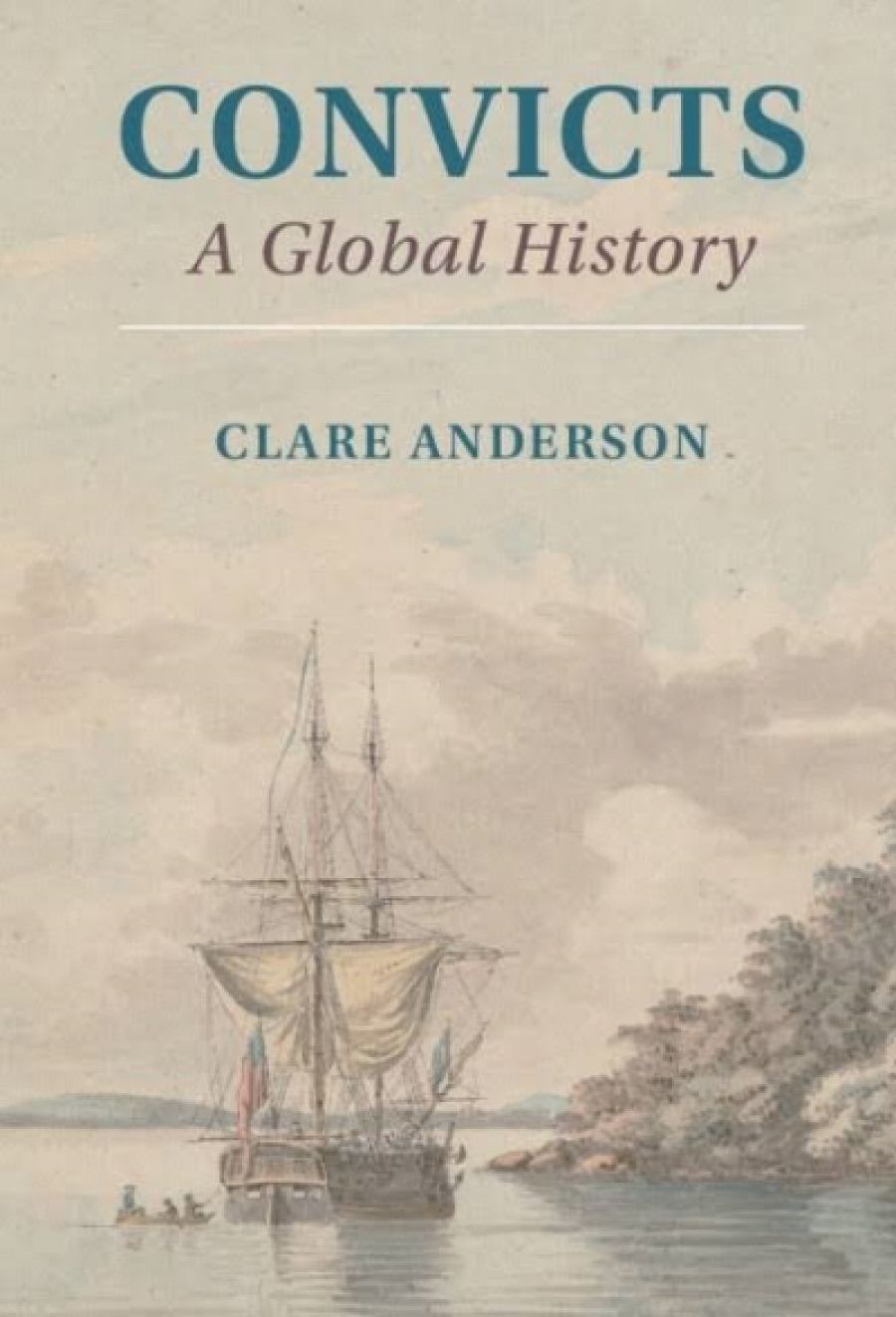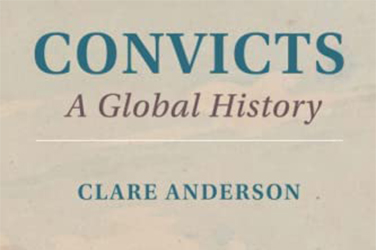
- Free Article: No
- Contents Category: History
- Review Article: Yes
- Article Title: Spreading the convict stain
- Article Subtitle: A wide-angled view of the history of punishment
- Online Only: No
- Custom Highlight Text:
In July 1887, a group of British naturalists set out from southern England bound for the Brazilian island of Fernando de Noronha in search of botanical specimens. They left Southampton with high expectations. Charles Darwin, in the 1830s, had visited Fernando as part of his Beagle expeditions and had remarked on the richness of the island, including its thick vegetation.
- Article Hero Image (920px wide):
_2.260_Mrs_LOUNT_INTERCEDING_WITH_SIR_GEORGE_ARTHUR%20copy.jpg)
- Article Hero Image Caption: 'Mrs. Lount interceding with Sir George Arthur', British Library HMNTS. 9555.eee.16 (Wikimedia Commons)
- Featured Image (400px * 250px):

- Alt Tag (Featured Image): Briony Neilson reviews 'Convicts: A global history' by Clare Anderson
- Book 1 Title: Convicts
- Book 1 Subtitle: A global history
- Book 1 Biblio: Cambridge University Press, $49.95 pb, 405 pp
- Book 1 Readings Link: booktopia.kh4ffx.net/b316vb
The experiences, encounters, and material traces of these British naturalists in the Brazilian penal colony serve as the fascinating and evocative opening of Australian historian Clare Anderson’s Convicts: A global history. Spanning six centuries, from the fifteenth to the twentieth, and detailing systems that encompassed almost the entire globe, Convicts is a tour-de-force account of the prevalence and endurance of the practice of ‘punitive relocation’. Motivated by a variety of concerns – the desire to manage troublesome populations (including political dissidents, petty offenders, and serious criminals), the wish to occupy and develop isolated geopolitical borderlands or islands, and the drive to make effective use of available manpower – a diverse array of empires and nations (Portugal, Spain, France, Britain, Italy, Russia, Austria-Hungary, the Netherlands, Denmark–Norway, China, Japan, and various independent Latin American countries) used convict transportation. Anderson’s stated goal is to ‘write a new global history from below’ by looking closely at convicts’ lives and at how they found agency in and resisted their condition. Situating penal transportation within a continuum of exploitative work practices, including indigenous labour, enslavement, indenture, and bondage, Anderson illuminates the overlapping and contrasting experiences of convicts, colonised peoples and the subaltern.
The book is organised into two parts. In the first, Anderson examines the context in which punitive relocation was adopted and shows the connections between convicts and the history of unfree migration and coerced labour, especially of the enslaved. In the second, which focuses primarily on the late modern period, Anderson reveals how these practices fit within the history of punishment and exposes the role of convicts in shaping knowledge and systems of classification, whether as collaborators in scientific enquiry (as in the case of Marçal de Corria) or as objects of study themselves (with research conducted on criminals’ bodies, intersecting in turn with racialised ideologies).
Readers expecting a starring role for early British colonisation of Australia are in for a surprise. While penal colonisation in the Australian colonies certainly figures in the narrative, Anderson reveals a system that is far bigger and more interconnected than much of the existing literature has allowed (tied, as it so often has been, to the histories of particular national or imperial constellations). Anderson’s wide-angle temporal lens also serves to unsettle prevalent assumptions in the history of punishment that tend to emphasise the ubiquity of the penitentiary, the main alternative to convict transportation. Transportation and penal colonialism were remarkably tenacious over the centuries, and the logic of containment and correction was often subsequently transferred onto other, non-convict populations, especially enslaved and indigenous peoples. Expanding on the work of historian Alan Lester, Anderson shows how ideas about indigenous ‘protection’ and slave ‘amelioration’ became intertwined with philosophies of convict ‘rehabilitation’. In some cases, this interlacing of thinking and techniques was performed by the same colonial administrators who moved from one colonial space to another, bringing experiences and practices with them, and applying them in new contexts. Among these globe-trotting colonial administrators was George Arthur, who, prior to becoming governor of Van Diemen’s Land in 1823 and lending his name to the notorious penal settlement of Port Arthur, was a superintendent and commander of the British settlement in Honduras.
Arthur figures prominently in one of the most compelling and fascinating cases Anderson discusses: the transportation
of enslaved rebels following the Barbados Rebellion of 1816. Anderson describes this case (known as Bussa’s Revolt) as ‘a slave voyage in reverse’. As Britain’s most established sugar colony, Barbados was highly prized by the British and fiercely protected not only against foreign powers eager to get a slice of the sweetest of pies, but also against the enslaved peoples who worked on the island’s plantations. In the wake of the successful slave revolution in France’s Caribbean colony of Saint-Domingue (Haiti), officials and plantation owners feared a repeat elsewhere. When hundreds rose up in Barbados, they were met with merciless force by the British; the rebels rounded up, the ringleaders executed, and the remainder put on a ship bound for Honduras.
On arrival at Honduras, however, Commander Arthur refused to allow the slave convicts to disembark on the grounds that there was nowhere secure to detain them. In the end, after much time had elapsed and many of the Barbados rebels had perished from rampant disease, the ship was redirected to Sierra Leone. There, the convicts were received in the capital, ‘Freetown’, which the British had been developing as a site of forced (though not punitive) settlement for people of African origin (including ‘black loyalists’ – formerly enslaved persons who had become refugees as a result of supporting the British against the Americans in the Revolutionary War), and from which the colonial administrators expected ‘civilisation’ to spread into west Africa. Anderson explains how these Barbados slave-convicts and the administrators who adjudicated over their destinies were bound up in networks that connected geographically distant islands, littorals, ports, and cities. Their lives and experiences highlight the entangled histories of enslavement, imperial governance, and penal transportation.
At more than 400 pages, Convicts: A global history is a weighty volume. The text is usefully supplemented by various tables and maps which illustrate the scale and reach of the practice – the areas affected by penal transportation appear like threads holding the globe together. Unfortunately, the index does not do justice to the richness of the book; it is lacking in comprehensiveness, a not insignificant weakness for such a wide-ranging text. The temporal, geographical, and analytical scope of Anderson’s analysis is extremely impressive, as is the list of archival collections she has consulted. Adopting a wide lens can risk obscuring specificities and reducing the depth of human experience. Anderson, however, manages masterfully to avoid such traps. This is an expansive yet fine-grained exploration of the national, regional and global history of punitive mobility. Weaving together a complex array of cases and conditions, Anderson engages the reader in an analysis of a system that not only affected the lives and fates of millions of people, but has shaped ways of thinking about and organising the world that endure into the present.


Comments powered by CComment